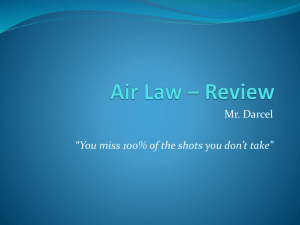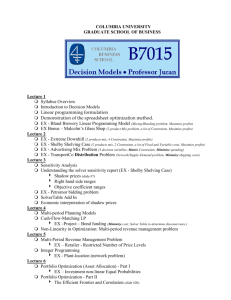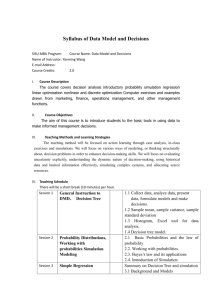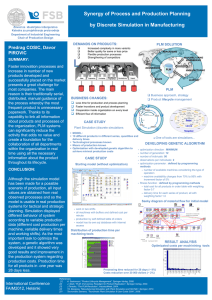Modeling NextGen Functions in Future ATM Concepts Evaluation Tool (FACET)
advertisement
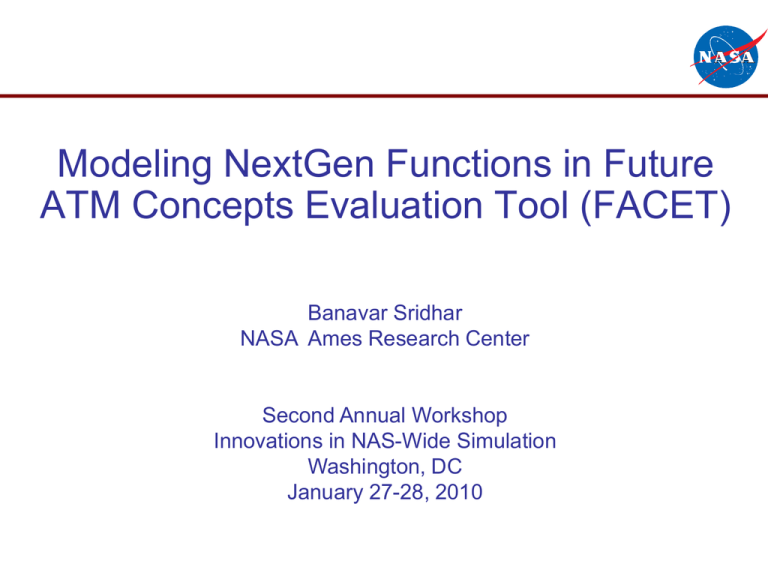
Modeling NextGen Functions in Future ATM Concepts Evaluation Tool (FACET) Banavar Sridhar NASA Ames Research Center Second Annual Workshop Innovations in NAS-Wide Simulation Washington, DC January 27-28, 2010 Outline • NASA ATM Research in Traffic Flow Management • FACET Baseline Capability • New Functionality –Simulation and Optimization –Integration of TFM and TMA Concepts –Collaborative Decision-Making –Environmental Models and Trajectory Optimization • Concluding remarks 2 Integrated TFM Solution User schedules and flight plans Observed traffic National Airspace System Weather Translation TFM Simulation 20 min - 8 hrs Meteorological Data Metrics • Aircraft-level (FACET) • Aggregate-level TFM Decisions Airspace Adaptation Data Traffic Predictions TFM Optimization Collaborative Traffic Flow Management Investigate modeling, simulation and optimization techniques to minimize total system delay (or other performance functions) subject to airspace and airport capacity constraints while accommodating three times traffic in the presence of uncertainty 3 Software Environment • FACET – Software environment for developing and testing Traffic Flow Management and Dynamic Airspace Concepts – AIAA Engineering Software of the Year (2009) – Available to universities world-wide and U.S. companies • Integration with Optimization Methods – Integrated with MATLAB tools – Integrated with Linear Programming (CPLEX) tools • Integration with other NASA ATM Software Systems – Center-TRACON Automation System (CTAS) – ACES (Airspace Concept Evaluation System) 5/28/2016 4 Interaction of Simulation and Optimization Coordinated TFM and TMA Operations* * S. Grabbe, B. Sridhar, A. Mukherjee and A. Morando, “Integrated Strategic and Local Arrival Flight Scheduling,” Submitted to the AIAA Guidance, Navigation and Control Conference, 2-5 August 2010, Toronto, Canada 6 Motivation • Traffic flow management currently accomplished through a loosely coordinated set of national and regional level controls • Predicted interactions and integrated impact of these controls are not well understood - Long (sometimes duplicate) predeparture delays assigned to some flights - and inconsistently control traffic flows - GDP assigns EDCT to satisfy the airport capacity constraint - TMA delays flight to fit it into the overhead stream • Controls tend to under, over, and inconsistently control traffic flows 3 of 17 Objectives • Develop an integrated test-bed to facilitate integrated traffic flow management and metering studies • Explore concepts and models for improving the interoperability between traffic flow management and metering. 8 of 17 GDP scenario at DFW 9 Simulation and analysis of aircraft trajectories with environmental constraints* *N.Chen, B. Sridhar and H.Ng, “Strategies for Reducing Contrail Formations Using Predicted Contrail Frequency Index,” Submitted to the AIAA Guidance, Navigation and Control Conference, 2-5 August 2010, Toronto, Canada. B.Sridhar, N. Chen and H. Ng,Simulation and optimization methods for assessing the impact of aviation operations on the environment,” 27th Congress of the International Council of the Aeronautical Sciences (ICAS), 19-24 September 2010, Impact of Aviation on Climate Change* • Increased urgency to deal with factors affecting climate change • Climatic changes include – Direct emissions: CO2 , Water vapor and other greenhouse gasses (best understood) – Indirect effects from NOx affecting distributions of Ozone and Methane (Ozone and Methane effects have opposite signs) – Effects associated with contrails and cirrus cloud formation • Aviation responsible for 13% of transportation-related fossil fuel consumption and 2% of all anthropogenic CO2 emissions • Large uncertainty in the understanding of the impact of aviation on climate change *“Workshop on the Impacts of Aviation on Climate Change,” June 7-9, 2006, Boston, MA. 11 Why another simulation? • Focus on impacts of subsonic aviation emissions at cruise altitudes in the upper troposphere and lower stratosphere (~14Km and above) –Emissions at cruise altitudes have a larger impact than emissions on the surface • Need a air traffic simulation and optimization tool-box with fuel, emission and contrails models 12 Environmental Considerations* 13 Environment Simulation Modules • Aircraft Dynamics – 3-DOF equations • Wind models – RUC 40/20 KM grid • Contrails – Computed using RUC data • Fuel burn – Leverage FAA SAGE models • Emission – Leverage FAA SAGE models • Trajectory optimization 14 Contrails • Occur if ambient temperature along the aircraft trajectory is colder and moister than a threshold defined by thermodynamic parameters • Contrails persist under certain conditions (Relative humidity with respect to ice >100%) • Effect different during night and day 15 Persistent Contrail Formation Model RHw (% ) at 225 hPa RHi>100% at 225 hPa RHW Contours RHi (% ) at 225 hPa RHI Contours Aircraft Rhi>100% Persistent Contrail RHI>100% Contours 16 Contrail Frequency Index Trade-offs Amongst Aviation Emissions Impacting Climate • Flight altitude effects on ozone, contrail formation and other effects • Differential impact of night and day operations • Routings to avoid certain regions with specialized chemistry (e.g. supersaturated air, cirrus, or polar) 18 Fuel optimal contrail avoidance aircraft trajectories • Fuel optimal trajectories generated using point mass aircraft dynamics and trajectory optimization based on Singular Perturbation Theory 19 Concluding Remarks • Presented recent changes to FACET software to enable evaluation of TFM concepts in support of NextGen • Emphasized current research on TFM-TMA interaction and environmental modules 20 Key TFM Research Activities Weather Impacted Airspace/Airport Capacity Estimation (AFD/Chan, AFD/Love, TI/Wolfe, TI/Wang, AFC/Sheth, UARC/Islam, MIT-LL, NRA/Krozel, NRA/Cook) National Airspace System User schedules and flight plans TFM Simulation 20 min - 8 hrs Weather Data Airspace Adaptation Data Integration of TFM Capabilities (AFC/Grabbe, UARC/Mukherjee, UARC/Morono, UARC/Lock) Observed traffic Weather Translation TFM Decisions Aggregate-level Demand Estimation and Flow Modeling (AFC/Bloem, NRA/Bayen, TI/Timucin) Metrics for Correlating the Performance of the NAS with Weather (AF/Sridhar, UARC/Chen, TI/Wang, TI/Kulkarni, AFD/Walker) Traffic Predictions • Aircraft-level • Aggregate-level TFM Optimization Collaborative Traffic Flow Management Weather Rerouting (AFC/Grabbe, UARC/Mukherjee, UARC/Ng Metrics Assigning Aircraft-level Delays to Satisfy Airport/Airspace Constraints (AFC/Rios, AFC/Grabbe, UARC/Mukherjee, TI/Agogino, NRA/Ball, NRA/Clarke) Influence of User Preferences on Flight Routing (AFC/Sheth, AFC/Bilimoria, TI/Wolfe, TI/Enomoto, UARC/Jarvis, NRA/Idris) 21 FACET Software Architecture National Weather Service FAA Traffic Data Winds Severe Weather FACET CORE FEATURES Air and Space Traffic Integration Route Parser & Trajectory Predictor Data Visualization Historical Database User Interface Climb Aircraft Descent Performance Cruise Data Adaptation Data Airborne Self-Separation Tracks Flight Plans Airspace Airways Airports APPLICATIONS Traffic & Route Analyzer Direct Routing Analysis Controller Workload System-Level Optimization Traffic Flow Management Simulation and Optimization Java Application Read/Implement Flight Controls FACET NAS Simulation Generate/Introduce Simulation Uncertainties Run optimization model in CPLEX/AMPL 4D Trajectories Weather Forecasts Start Simulation Application Program Create CPLEX/AMPL Input File Interface Repeat N time steps Log airspace/airport occupancy/usa ge statistics Generate weather impacted airspace/airport capacity Flight Controls System Uncertainties Flight Schedules Weather Forecasts Airspace Configuration 23 Aircraft Dynamics • Flat-Earth, inertial reference, point mass aircraft model xÝ V cos cos u(x, y) yÝ V sin cos v(x, y) EÝ (T D)V /mg hÝ V sin Ý (L cos mgcos ) /mV Ý L sin /mV cos mÝ (h,V,T) • Find the optimal trajectory given the arrival and departure airports, wind conditions subject to environmental conditions Trajectory Optimization Options • No winds • Separate route and altitude profile optimization –Near optimal wind routes –Dynamic programming –Singular perturbation –Linear programming –Heuristics • Inclusion of contrail constraints (state constraints) 25

